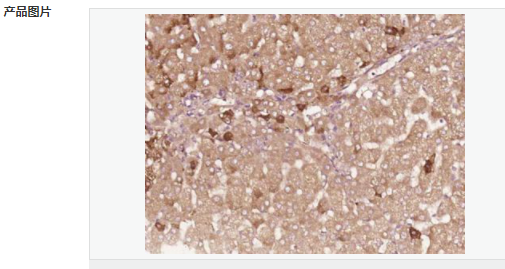

貨號(hào)
產(chǎn)品規(guī)格
售價(jià)
備注
BN40768R-100ul
100ul
¥2360.00
交叉反應(yīng):Human(predicted:Mouse,Rat,Pig,Cow,Sheep) 推薦應(yīng)用:IHC-P,IHC-F,IF
BN40768R-200ul
200ul
¥3490.00
交叉反應(yīng):Human(predicted:Mouse,Rat,Pig,Cow,Sheep) 推薦應(yīng)用:IHC-P,IHC-F,IF
產(chǎn)品描述
| 英文名稱 | DTSF/HB-EGF |
| 中文名稱 | 肝素結(jié)合性表皮生長(zhǎng)因子抗體 |
| 別 名 | HB EGF; Diphtheria toxin receptor; DT R; DT-R; DTR; DTS; DTSF; HB-EGF; HBEGF; HBEGF_HUMAN; HEGFL; heparin binding EGF like growth factor; Heparin binding epidermal growth factor; Heparin binding epidermal growth factor like growth factor; Heparin-binding EGF-like growth factor; Proheparin binding EGF like growth factor. |
| 研究領(lǐng)域 | 腫瘤 心血管 免疫學(xué) 信號(hào)轉(zhuǎn)導(dǎo) 生長(zhǎng)因子和激素 血管內(nèi)皮細(xì)胞 |
| 抗體來(lái)源 | Rabbit |
| 克隆類型 | Polyclonal |
| 交叉反應(yīng) | Human, (predicted: Mouse, Rat, Pig, Cow, Sheep, ) |
| 產(chǎn)品應(yīng)用 | IHC-P=1:100-500 IHC-F=1:100-500 ICC=1:100-500 IF=1:100-500 (石蠟切片需做抗原修復(fù)) not yet tested in other applications. optimal dilutions/concentrations should be determined by the end user. |
| 分 子 量 | 21kDa |
| 細(xì)胞定位 | 細(xì)胞膜 分泌型蛋白 |
| 性 狀 | Liquid |
| 濃 度 | 1mg/ml |
| 免 疫 原 | KLH conjugated synthetic peptide derived from human DTSF/HB-EGF:20-62/208 <Extracellular> |
| 亞 型 | IgG |
| 純化方法 | affinity purified by Protein A |
| 儲(chǔ) 存 液 | 0.01M TBS(pH7.4) with 1% BSA, 0.03% Proclin300 and 50% Glycerol. |
| 保存條件 | Shipped at 4℃. Store at -20 °C for one year. Avoid repeated freeze/thaw cycles. |
| PubMed | PubMed |
| 產(chǎn)品介紹 | Heparin-binding epidermal growth factor-like growth factor (HB-EGF) is a 22kDa O-glycosylated protein that is a potent mitogen and chemoattractant for vascular smooth muscle cells, fibroblasts and epithelial cells but not endothelial cells. The natural protein has an apparent molecular mass of 19-23 kDa and exists in multiple forms as a result of heterogeneous O-glycosylation and/or Nterminal truncation. HB-EGF is synthesized as a membrane-anchored precursor(proHB-EGF) that is proteolytically cleaved to release the soluble mature growth factor. The two forms are active as juxtacrine and paracrine/autocrine growth factors respectively.HB-EGF activates two EGF receptor subtypes, HER1/ErbB1 and HER4 and binds to heparan sulfate proteoglycan. Function: Growth factor that mediates its effects via EGFR, ERBB2 and ERBB4. Required for normal cardiac valve formation and normal heart function. Promotes smooth muscle cell proliferation. May be involved in macrophage-mediated cellular proliferation. It is mitogenic for fibroblasts, but not endothelial cells. It is able to bind EGF receptor/EGFR with higher affinity than EGF itself and is a far more potent mitogen for smooth muscle cells than EGF. Also acts as a diphtheria toxin receptor. Subunit: Interacts with FBLN1. Interacts with EGFR and ERBB4. Subcellular Location: Heparin-binding EGF-like growth factor: Secreted, extracellular space. Note=Mature HB-EGF is released into the extracellular space and probably binds to a receptor. Proheparin-binding EGF-like growth factor: Cell membrane; Single-pass type I membrane protein. Post-translational modifications: Several N-termini have been identified by direct sequencing. The forms with N-termini 63, 73 and 74 have been tested and found to be biologically active. O-glycosylated with core 1 or possibly core 8 glycans. Thr-47 is a minor glycosylation site compared to Thr-44. Similarity: Contains 1 EGF-like domain. SWISS: Q99075 Gene ID: 1839 Database links: Entrez Gene: 1839 Human Omim: 126150 Human SwissProt: Q99075 Human Unigene: 799 Human Important Note: This product as supplied is intended for research use only, not for use in human, therapeutic or diagnostic applications. |
